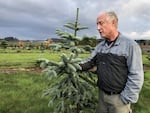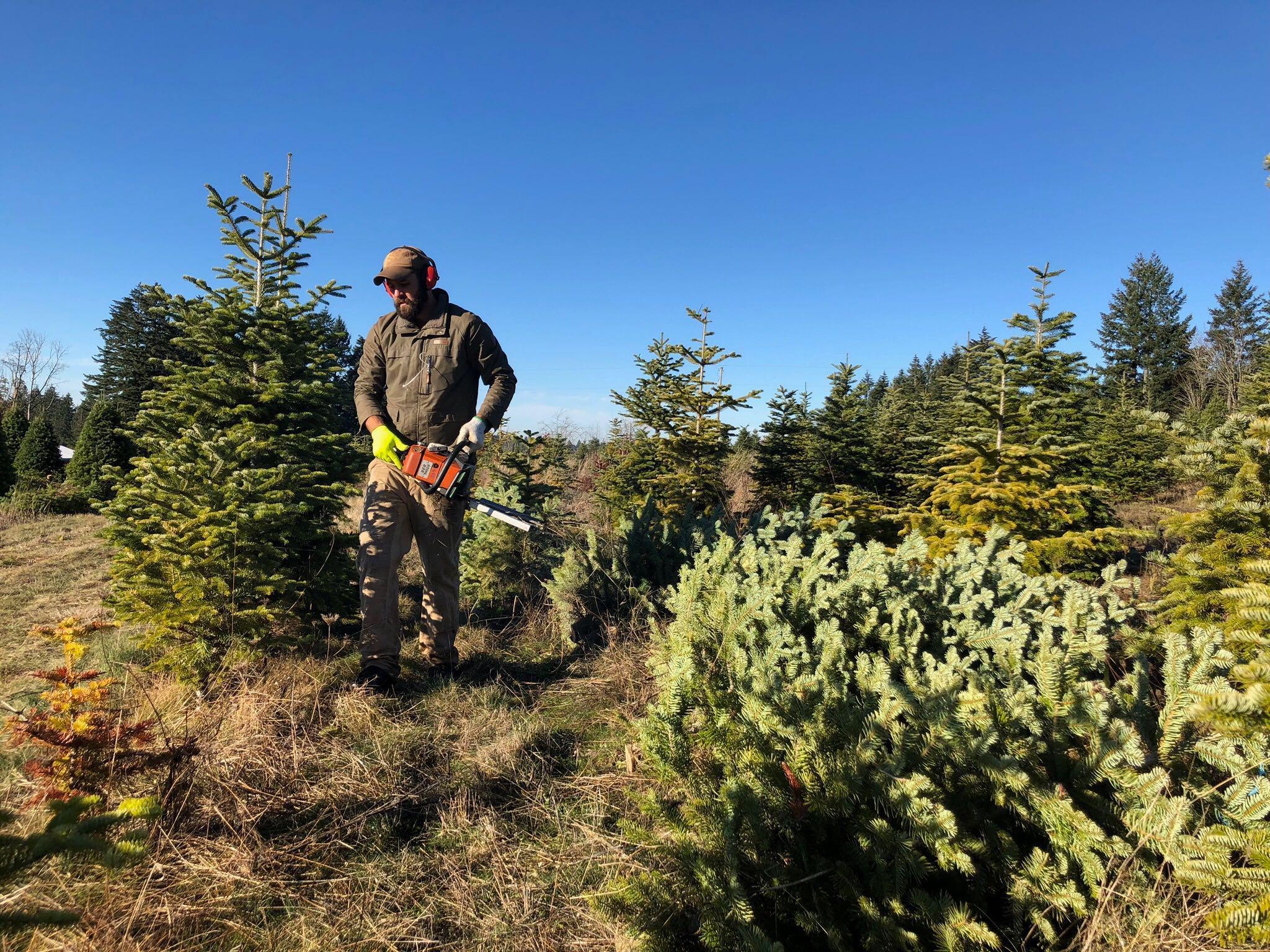Julie Madison-Jamil didn’t expect she’d need a cooler just for hauling dead birds to necropsies.
In 2016, she and her husband Daanish moved into a fixer-upper lot outside Oregon City with dreams of a small organic egg and vegetable farm. They filled the property with bantam chickens, silkies, sweetgrass turkeys and Guinea fowl.
Since then, they have unexpectedly lost dozens of birds to ailments including liver damage and cancer. The necropsies have not solved the mystery, but Madison-Jamil thinks she has.
Their property is surrounded by Christmas tree farms. Those farms routinely spray pesticides to kill weeds and insects that damage trees.
“You can taste it. You can smell it,” she said, when spraying happens nearby. It burns her throat and gives her headaches.

Julie Madison-Jamil and one of the chickens she raises.
Tony Schick / OPB
Early on, Madison-Jamil had little hard proof connecting those chemicals to her own symptoms or the death of her birds. But her hunch led to quarrels with the Christmas tree growers nearby. She complained frequently to them and about them. She posted scathing reviews on their social media pages urging people to buy artificial trees instead.
Then last year, one of the formal complaints she submitted to the Oregon Department of Agriculture turned up something she found interesting: chlorpyrifos.
Chlorpyrifos is a chemical the Environmental Protection Agency was close to banning because of its potential harm to children and farmworkers. That was before President Donald Trump took office. Two months before the chemical showed up on Madison-Jamil's farm, his administration reversed course on a ban, rejecting the recommendations of the agency's scientists.
The chemical has been crucial to Northwest crops, despite studies showing its potential for bodily harm. Environmental groups have wanted it banned for more than 10 years. Dow Chemical, which introduced it in 1965, and others in the industry say its approved uses are safe and question the science showing negative health effects.
Chlorpyrifos remains in use, its fate now dragging out in the 9th Circuit Court of Appeals, and potentially in the Supreme Court after that.
Twenty months have passed since the EPA reversed course on chlorpyrifos. In that time, the pesticide has generated at least 18 reports of pollution, unsafe exposure of human and animals and contamination of nearby crops in Oregon and Washington, records show.
Here is a sampling: Investigators determined the pesticide drifted from a Christmas tree farm onto Madison Jamil's property. Chlorpyrifos also poisoned crayfish after running into a creek in Hermiston, Oregon. A laborer in Wenatchee, Washington, was sickened by drift while performing farm work. Two county workers in Dallas, Oregon were exposed to a cloud of it while trying to clean out a culvert. A father in Quincy, Washington, was so concerned about chlorpyrifos being applied to a neighbor's fruit trees that he purchased the orchard to make sure the spraying stopped.
To be sure, chemical drift and exposure incidents are not unique to any one pesticide.
Chlorpyrifos, in particular, catches the attention of health officials because of its widespread use, its acute toxicity and the fact that it’s been linked to diminished memory and verbal comprehension, lower IQs and higher rates of attention deficit and hyperactivity disorder and impulsive behavior in children who have been exposed.
“It’s not just about one chemical, albeit if you had to choose a chemical, one single chemical that’s out there in use, chlorpyrifos would be at the top of my list,” said Joanne Bonnar Prado, epidemiologist for the Washington Department of Health.
Prado cautioned that banning one harmful chemical does not necessarily mean it will be replaced by a safer alternative. On orchards, chlorpyrifos was preceded by the now out-of-use azinphos-methyl, which was preceded by DDT. Before DDT, farmers sprayed lead arsenate.
“I've been in the field for 30 years and I've seen what had been thought of as relatively innocuous turn out to be not so not so safe,” Bonnar Prado said.
Related: This Pesticide Poisons Kids, But It's Still Sprayed On Washington Orchards
In the absence of federal regulation, at least two states — California and Hawaii — announced their own restrictions on chlorpyrifos. Oregon and Washington have not. Washington Attorney General Bob Ferguson has joined several states in a lawsuit asking the EPA to ban chlorpyrifos.
The EPA declined a request for an interview and said it would not comment on pending litigation.
Oregon Gov. Kate Brown’s office declined an interview on the subject. Washington Gov. Jay Inslee’s office directed questions to the state’s agriculture agency, but added that the governor had no plans to ban chlorpyrifos. Future actions could depend on whether the states’ legislatures take up the cause or if the courts rule to keep or overturn a ban.
The Go-To Chemical
Chlorpyrifos use has been on the decline nationwide. A big reason: some of the nation's biggest farm states produce mostly corn and soybeans — crops for which newer pesticides have been approved.
But chlorpyrifos use has not dropped as rapidly in the Northwest. Estimates of its use in Oregon and Washington are lower than their peaks in the early 2000s, but remain consistent with where they were in the early 1990s, according to an OPB analysis of pesticide use estimates from the U.S. Geological Survey.
Chlorpyrifos Use In The Pacific Northwest
Low-end estimates for Oregon and Washington show chlorpyrifos use spiked in the early 2000s, before gradually falling to rates similar to the early 1990s. Orchards and grapes remain the dominant use.
Tony Schick, OPB. Source: US Geological Survey Pesticide National Synthesis Project.
It is particularly important in Pacific Northwest agriculture because of the region’s crop diversity, said Scott Dahlman, a pesticide industry lobbyist in Oregon. It is one of few insecticides that is effective and government-approved for use on almost all of them: Christmas trees, grass seed, hazelnuts, asparagus, pears, wheat and more.
“Something like Christmas trees, very key this time of year, one of the only insecticides they have to use is chlorpyrifos,” said Dahlman, who works for a pro-chemical organization that goes by the name, Oregonians For Food and Shelter.
Dahlman’s group filed a brief in the court case over chlorpyrifos, arguing against a swift ban he fears would leave farmers without time to find alternatives.
The Pacific Northwest produces about 8 million Christmas trees every year, shipping them across the country and internationally. Without the ability to control aphids or other pests, stands of grand, noble or Douglas fir could become grayed, blackened, twisted or otherwise blemished enough that some could be unsellable.
Chlorpyrifos Use Across The Country
As new pesticides have been introduced, chlorpyrifos faded in the corn and soybean growing regions of the Midwest. But in some regions, it remains in frequent use.
Tony Schick, OPB. Source: US Geological Survey Pesticide National Synthesis Project.
Chlorpyrifos is used commonly enough that when investigators found it on Madison-Jamil’s property, they contacted three nearby tree farms before determining which had sprayed that day.
"It's not particularly pleasant to be around. But it works on aphids," said Chal Landgren, a Christmas tree expert with Oregon State University. "Nobody wants to wear respirators and Tyvek suits out spraying. That's a concern for growers, applicators, everybody."
Landgren said he’s been exploring alternatives. Some of those include using nontoxic solutions to prevent pests from reproducing.
Right now, alternatives to chlorpyrifos are roughly four to five times as expensive, he said.
Growing without insecticide can be done.
In 2012, Landgren helped start a program to certify farms that produce more socially and environmentally responsible Christmas trees.

Chal Landgren is a Christmas tree expert with Oregon State University.
Tony Schick / OPB
Growing A Chemical-Free Tree
On a crisp December morning at Green Valley Farm, in Molalla, Oregon, farmhand Grant Robinson was cutting and baling Christmas trees for a last-minute shipment.
The farm shipped 9,000 trees this year. None of them were sprayed with chlorpyrifos or any other insecticide.
“We just let the trees grow the way God intended them to. I’d rather have that in my house than a tree that’s full of chemicals any day,” Robinson said.
Owner Terry Muilenburg said the farm uses a combination of ground cover and natural pest predators — such as ladybugs and spiders — to fight the pests they don’t want, including aphids. They also simply tolerate more pest damage.
Muilenburg said some years he wished he had sprayed. There are other years in which fellow farmers sprayed three times and still had damage when he didn’t. But he is a small-scale grower, and his methods don’t translate so easily to the farms producing millions of trees.

Terry Muilenburg’s tree farm near Molalla, Ore., uses non-toxic methods to control pests.
Tony Schick / OPB
He can’t charge more, as demand is not high for pesticide-free trees. Customers want a cheap, good looking tree without spiders in it, he said. Some countries, such as Mexico, have strict pest-control rules on imports that effectively require spraying between three and six weeks before harvest.
Whether there’s any risk of exposure from pesticide residue on Christmas trees once they are inside the home has has not been studied thoroughly. Experts like OSU’s Landgren say it is unlikely. Muilenburg and others are not so sure.
“How do you know?” Muilenburg said. “I don't want it in my house, period.”
And yet, he’s not sold on the idea of banning chlorpyrifos.
“Now to do that through regulation? Eh, I’m not a big one on a police-state kind of thing,” he said. “Once I learn about what these things can do, then I monitor myself. Now, I suppose not everybody’s going to do that.”
Out of about 400 growers in Oregon, Muilenburg is one of three that participate in Landgren’s Socially and Environmentally Responsible Farm program. Together, they account for less than 1 percent of the region’s Christmas tree production.
KUOW’s Eilís O’Neill contributed reporting.
Correction: Dec. 17, 2018. An earlier version of this story incorrectly states that chlorpyrofis can be used effectively and with government approval as a pesticide on cannabis plants.



